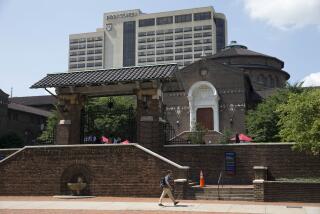Preserved Heads Buried After 50-Year Odyssey
- Share via
WALTHAM, Mass. — The heads of two men believed to be prisoners executed during the Spanish Civil War lay in peace Wednesday after a half-century spent being shuffled between laboratories, museums and countries.
The heads were buried in infants’ coffins at a common graveyard in a far, wooded corner of the Metropolitan State Hospital. A rabbi, a Protestant minister and a Catholic priest presided over the private ceremony because the men’s religions were unknown.
“These two persons, I think, have been subject to sufficient indignity and we would like to have them interred quietly without attracting too much attention,” said Roy Ross, a spokesman at the Eunice Kennedy Shriver Center for Mental Retardation Inc., where the heads were stored for years in porcelain pots.
The heads were brought to the Boston area for medical research in the 1930s and spent time in at least two laboratories and a museum before ending up in the basement of the mental retardation center, Ross said.
Previous Efforts
Officials tried several times to bury them or donate them to other institutions, but no one wanted the heads, said Dr. Roger Williams, associate director of the Shriver center.
“They had no educational value,” Williams said. “And probably because of the lack of identity, no funeral homes wanted to be involved.”
A worker reopened the debate two weeks ago when he discovered the heads while working in the basement of the Shriver center in this Boston suburb. The specimen pots containing them were labeled “Pedro” and “Sexto.”
A state medical examiner reviewed the case and last week cleared the way for burial.
Well Preserved
The heads were remarkably well preserved, said Wayne F. Brasco, the funeral director who arranged the service. “It looks like they died yesterday.”
Williams said the heads were brought to the Boston area from Spain in the early 1950s by Harvard Medical School neurologist H. Hamlin, who used them in his research on Parkinson’s disease.
The heads were then passed on to another Harvard Medical School professor, Paul Yakovlev. Both doctors died years ago, Williams said.
Ross said the specimens were believed to be heads of men executed in the 1930s during the Spanish Civil War, but no one knows what side of the battle the men were on or why their heads were preserved after the execution.
More to Read
Sign up for Essential California
The most important California stories and recommendations in your inbox every morning.
You may occasionally receive promotional content from the Los Angeles Times.













